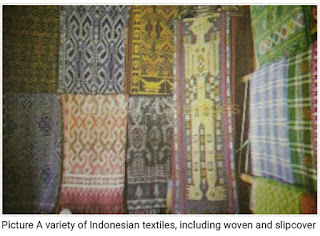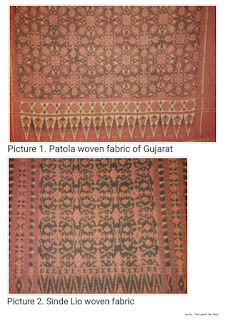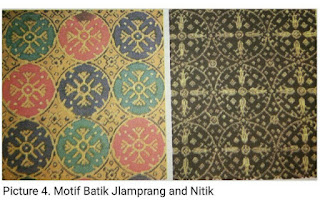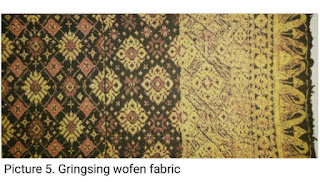Public Topics - Learn About Traditional Textile Handicraft Indonesian. Indonesian traditional textile craft works, it functions can be divided as follows :
- As the fulfillment of the needs of clothing that protects the body, such as the long cloth, slipcover and clothes area.
- As a tool or a household appliance, such as a baby sling and to carry goods.
- As a ritual (special outfit ritual certain traditions), for example:
- Ulos woven fabric
- Shroud wrapping, batik motif prayer
- theric tie-dye Eastern Indonesia (covering the corpse)
- Tapis for weddings Lampung society
- Fabric Cepuk to customary rituals on the island of Nusa Penida
- Fabric Songket for wedding and circumcisions
- Poleng fabric from Bali to show ruwatan (sanctification)
 |
| Indonesian textile traditional |
Traditional Indonesian textiles developed a good local creativity influence of ethnic or other nations. geographical history, the position of Indonesia is located at the intersection of great cultures, between the two continents of Asia and Australia, as well as the two oceans, the Indian Ocean and the Pacific Ocean. Contact wave of trade passing through the territory of the Indonesian archipelago and the resulting effect of acculturation (mixing) culture which looks at the development of the textile craft in Indonesia.
Traditional fabric in the Indonesian archipelago was originally a means of exchange / barter brought by immigrants and Native traders when buying crops and spices in Indonesia. around the 15th century AD, Arab and Indian Muslim traders do trade contacts by visiting the islands of Java and Sumatra. The influence of Islam is directly viewable on Indonesian textiles. In Indonesia there is also a plaid sarong and plain are widely used in the Arabian Peninsula, Northeast Africa, South Asia, Southeast Asia and the Pacific islands. in the 13th century, Gujarat merchant introduced the Patola fabric woven, namely fabric by tying double weaving technique of silk threads which are clothing Gujarat, in northwest India. Patola cloth-making process so complicated that in India the fabric is used in various ceremonies associated with human life, such as birth, marriage and death as well as a repellent reinforcements.
Through trade with nations Gujarat, where Patola cloth terse bar area in the archipelago. Patola fabrics generally owned only by a limited circle, locals have had the weaving skills trying to reproduce the very fabric of the precious bundle with feed. In Maluku, the fabric is very much appreciated and worn by means wrapped around the waist or neck of the weavers in East Nusa Tenggara develop a pattern of woven fabric that is affected by the pattern contained in the fabric Patola, with a different complexion to the king, officials and the head of customs in quantities very limited and only applies to traditional ceremonies. Patola fabrics from Lio NTT have made along the 4-meter-called katipa serves as a cover bodies.
Motif Patola affect motif Jlamprang brightly colored growing in Pekalongan, and motives Nitik growing in Yogyakarta and Surakarta colored sogan (brown), indigo (blue), yellow and white, pattern Patola also growing in Pontianak, Gorontalo, and fabric Bentenan weaving in Manado.
Creativity Indonesian people are able to develop the kinds of woven Patola Gujarat into a variety of textiles is very beautiful in all regions in Indonesia. Examples of these developments Patola cloth, just one example of evidence of high creativity that is owned by the Indonesian people. In traditional textiles, in addition to meeting the needs of clothing, also has a symbolic meaning behind its main function. Several traditional Indonesian fabrics are made to meet the wishes of its users to indicate social status and position in society as well as through the symbols form of decoration and color selection. There are also traditional Indonesian fabrics which is done by the tone of prayer, and decorate it with a word or a sentence prayer as the decoration. The goal, for wearing the cloth by the health, safety, and protected from harm.
Indonesia traditional cloth made with perseverance, meticulous precision in preparing the decoration, shades of color and meaning. Consequently, the resulting fabric Indonesia invited the admiration of the international community since it contains a high aesthetic value.
Thank you for reading my article. May be useful. Sorry if there is false in the writing and translation.
Indonesia traditional cloth made with perseverance, meticulous precision in preparing the decoration, shades of color and meaning. Consequently, the resulting fabric Indonesia invited the admiration of the international community since it contains a high aesthetic value.
Thank you for reading my article. May be useful. Sorry if there is false in the writing and translation.
















0 comments:
Post a Comment